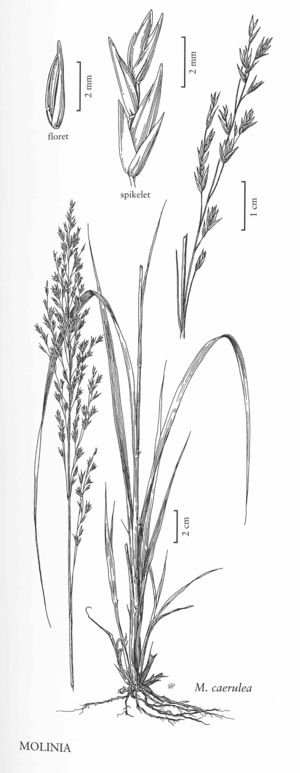| Taxon | Illustrator ⠉ | |
|---|---|---|
 | Molinia caerulea | Hana Pazdírková Linda A. Vorobik |
Plants perennial; cespitose, not rhizomatous. Culms 15-250 cm, often disarticulating at the first node, basal internodes persistent, often swollen and clavate. Leaves mostly basal; ligules of hairs; blades flat or convolute, eventually disarticulating from the sheaths. Inflorescences terminal, panicles, not plumose. Spikelets laterally compressed, with (1) 2-5 florets; rachilla prolonged beyond the distal florets, terminating in a rudimentary floret, internodes 1/3 – 1/2 as long as the florets, glabrous; disarticulation beneath the florets. Glumes exceeded by the florets, 1-veined or 3-veined; calluses 0.1-0.3 mm, blunt, glabrous or sparsely strigose, hairs to 0.5 mm; lemmas glabrous, inconspicuously 3 (5) -veined, rounded over the back, acute to obtuse, unawned; paleas subequal to the lemmas; anthers 3. Caryopses falling free from the lemmas and paleas; pericarps loosely adherent, x = 9.
Distribution
Maine, N.J., Mass., Conn., N.Y., Wis., R.I., Vt., Pa., N.S., Ont., Que., Oreg.
Discussion
Molinia is a genus of two to five species, all of which are native to temperate Eurasia. One species is established in the Flora region.
Selected References
Lower Taxa
"decumbent" is not a number.